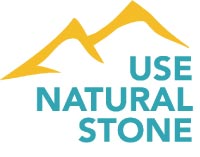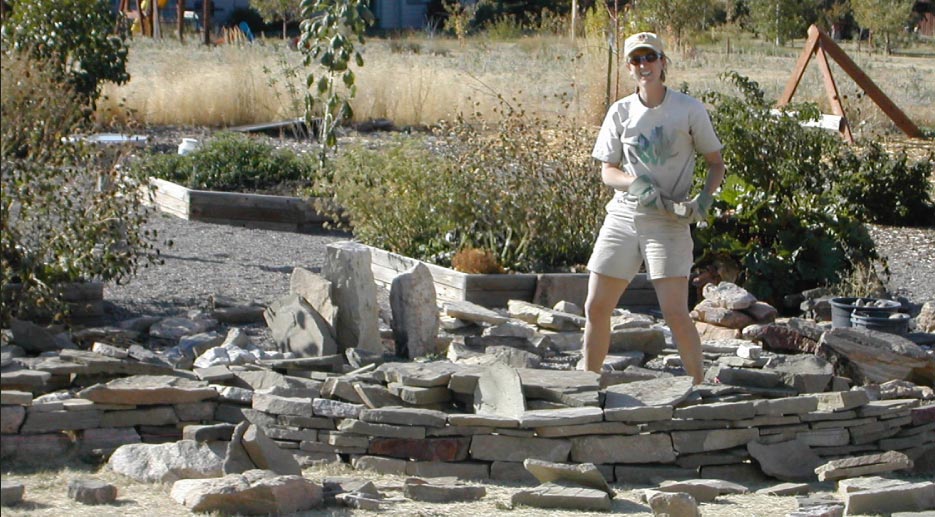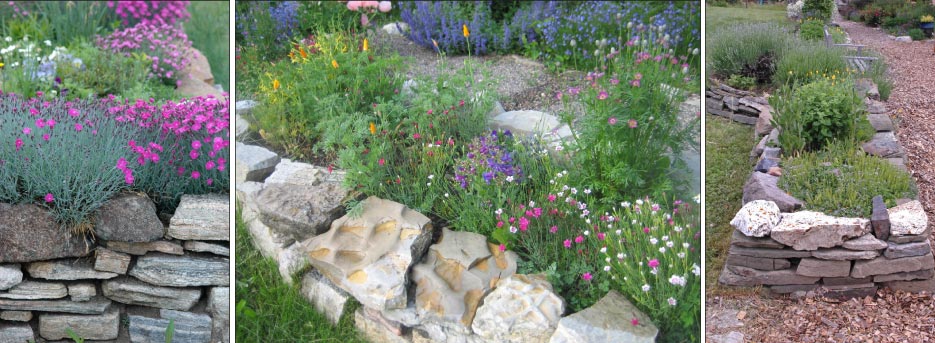Wall of Time
 A Geologic Stone Wall Captures Earth’s History
A Geologic Stone Wall Captures Earth’s History
Karin Kirk
usenaturalstone.com
All Photos by Karin Kirk
The pairing of plants and stone is a perfectly natural one. As a geologist and gardener, I’ve always admired the way wildflowers tuck themselves into the cracks in rocks and meld effortlessly into the alpine landscape. When I moved to Montana to get my Master’s degree in geology, I spent two summers bushwhacking through nearby mountains, mapping and measuring the rocks, learning the names of the wildflowers, and developing a deep appreciation for the landscape in which I was working.
 |
|
Kirk hand-selects stone to dry stack her Wall of Time. |
A Plan Forms
At the same time, I had a brand new house without a hint of landscaping. I wondered if I could re-create the dynamic between rocks and plants that I was enjoying while working in the mountains. A natural, dry-stacked stone wall seemed like a realistic project for a low-budget DIYer, particularly since I could collect the rocks myself. The US Forest Service offers permits for stone collecting, and I started hauling a dozen rocks home with me at the end of each day of geology field work. I fiddled with the ancient technique of building a dry-stacked stone wall, which uses no mortar and relies on gravity and the geometric fit of the stones to hold things together. I immediately became smitten with rock-stacking. Big plans for stonework danced in my head. I gathered more and more stones until my poor old pickup strained to make it home with each day’s haul. By the end of the summer, I had amassed a sizeable pile of several tons.
But, to a geologist, these aren’t just generic “rocks.” Each one marks a specific place in time, is made of characteristic minerals, and has a certain look. They are the Flathead Sandstone, made of pure quartz sand; the Meagher Limestone, whose turbulent deposits revealed chaotic storm waves churning across the ocean floor; the Lodgepole Limestone, chock full of fossils.
My stone wall idea developed a new twist. Instead of just stacking the stones any which way they fit together, I decided to use the stones in order of their geological ages, with old rocks on one end of the wall, and progressively younger and younger rocks down the length of the wall.
 |
|
Above, Left: The “old” end of the wall. These rocks are 2 billion year-old metamorphic rocks, aptly named “basement rocks.” Above, Middle: Oscillation ripple marks show how water sloshed around a shallow pool of water some 500 million years ago. Above, Right: The youngest stones in the wall are travertine from hot springs. There are also volcanic rocks from two episodes of volcanic activity in our region. |
Basement Rocks and Lots of Layers
With the plan set, I began building the wall, starting with the oldest rocks first. Our area’s oldest rocks are aptly-named “basement rocks” because they are the bottom-most layer of rock. These 2 billion year old metamorphic rocks are full of garnets and mica and often have swirled bands of minerals, evocative of the heated, fluid circumstances that shaped them. These rocks tend to be hard, dense, and blocky.
Once I used up my supply of basement rocks, I moved up the timeline to the next period in the geologic sequence. Our area has 20 different sedimentary layers that reflect the history of the region. Just like at the Grand Canyon, these sedimentary rocks are laid down like a layer-cake, with the oldest layers at bottom and the youngest ones at the top. Most of these layers are limestones, shales, and sandstones. Each layer marks the arrival of new conditions. The geologic history recounts the advance and retreat of prehistoric seas across the Western landscape, bringing coral reefs, tidal flats, and beaches. The latter parts of the story include vast river systems, inland seas, the rise and fall of dinosaurs, and two big episodes of volcanic activity.
Most of these events are captured in the stone wall. Tropical beaches left limestones brimming with fossil corals and shells. Tidal flats created mud cracks where sediment dried in the sun, 500 million years ago. Currents in shallow water formed ripple marks that show the direction the water flowed. The transition from shallow ocean to dry land is marked by the appearance of woody fossils and leaves. Lava flows oozed over the landscape, forming columnar basalt. All of these stones are vivid expressions of their geologic circumstances.
The process of building the wall was exquisitely slow. I was learning the skill of dry-stacking as I went along. I used few tools – mostly a lot of patience and sweat. Fitting the stones together was like a giant, real-life Tetris puzzle; an addictive, highly satisfying process.
 |
Like Visiting Old Friends
By the end of the second summer, I reached the “young” end of the wall. The youngest stones in the wall are travertine from Gardiner, Montana, which was formed from a hot spring outside Yellowstone National Park (collecting rocks – or anything else – from a National Park is strictly forbidden). All told, the wall is 110 feet long and covers a slice of geologic time from 2 billion years ago to 50,000 years ago. That’s nearly half of Earth’s total history.
With the hard work done, it was time for the fun stuff: adding the plants! The wall is essentially a long, raised bed. I filled it with soil and nestled alpine plants between the stones, just as I had seen in the mountains. Some of my favorites include penstemon, anemone, and alpine poppies.
It’s been 15 years since I built the wall, and it remains my favorite feature of our landscape. I never tire of the interesting fossils and small snapshots from our geological history. I like to revisit the fascinating rocks that I learned so much about during my graduate research; they’re like old friends. While the landscape all around the stone wall has grown and evolved over the years, the wall endures. In that way, it mimics the mountains it came from. Steady sentinels amid a changing world.
Karin Kirk is a geologist and science educator with over 20 years of experience. She has taught college level geology, online courses and organized field trips. She currently works as a freelance science writer and education consultant. She brings with her a different perspective to the stone industry. Karin was an education program presenter at TISE 2018 and a regular contributor to usenaturalstone.com and the Slippery Rock Gazette.